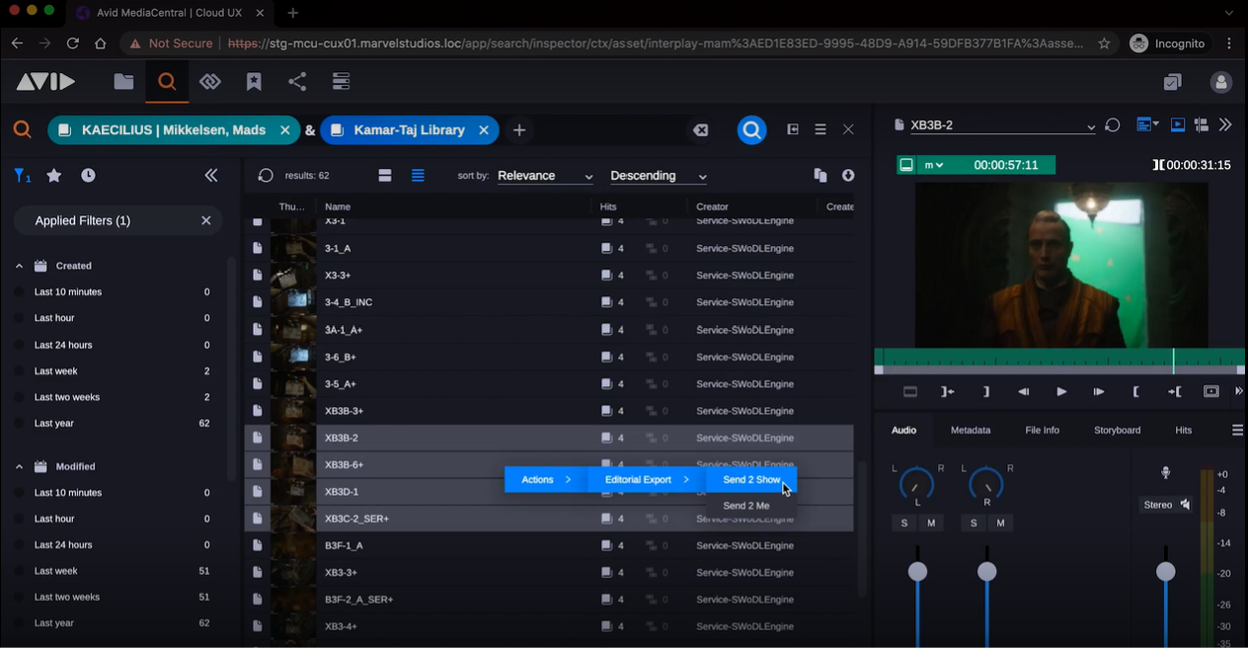Marvel Studios Cinematic Universe Editorial Library
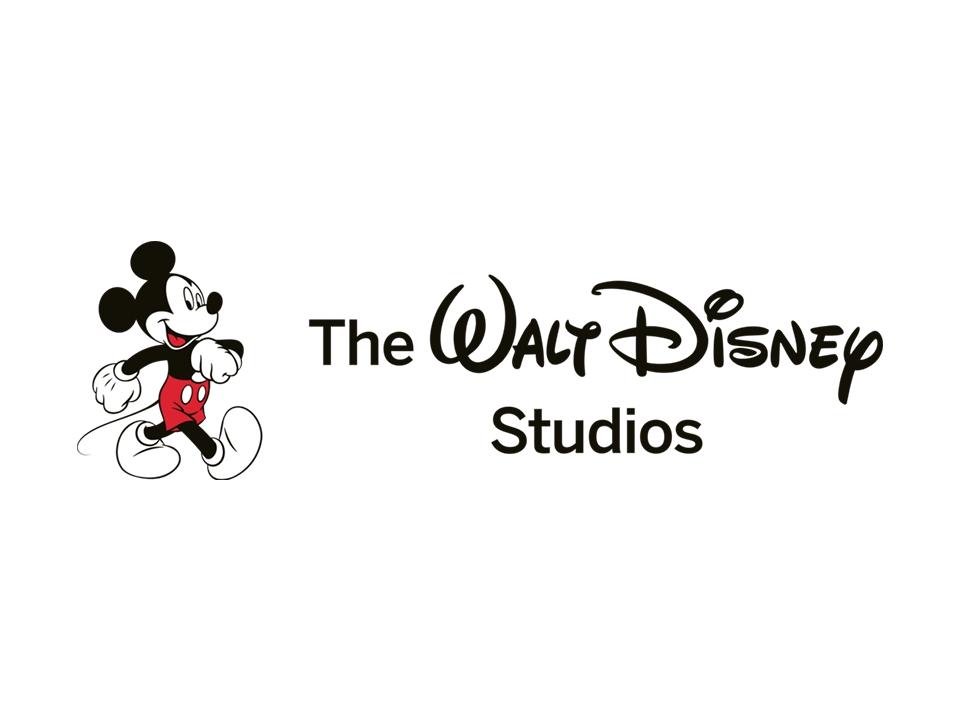

1-2 Weeks Reduced to
REAL TIME DATA RETRIEVAL
SELF-SERVE
280K
Assets Ingested So Far
Summary
Disney Studios collaborated with Avid to transform the offline Marvel Cinematic Universe (MCU) editorial archive into a real-time editorial library accessible by current productions and marketing teams. The system is a prime example of implementing key elements of the 2030 Vision to deliver an innovative archive experience with a secure, cloud-based search capability that streamlines production and marketing workflows.
The MCU-EL (Marvel Cinematic Universe – Editorial Library) is built on a private cloud available to authorized Marvel Studios users around the globe. The solution customizes and extends existing applications to bring years of editorial footage, representing the vast Marvel Studios cinematic canon, into a searchable library for production users. The new editorial library turns what was a manual, multi-participant, time-consuming offline search to find reusable assets into a self-service, real-time experience for users with zero manual work by editorial support personnel. It utilizes custom product extensions to Media Composer and other Avid products developed in a way that allows Avid to productize the solution for the entire industry.
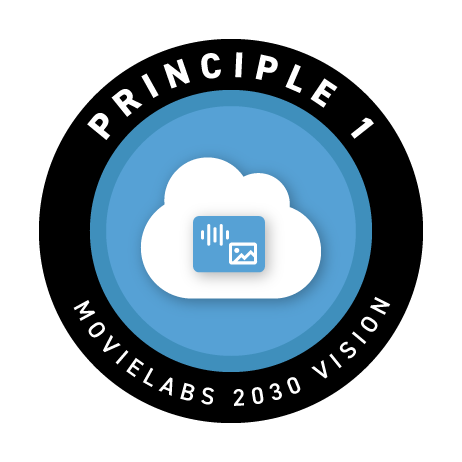
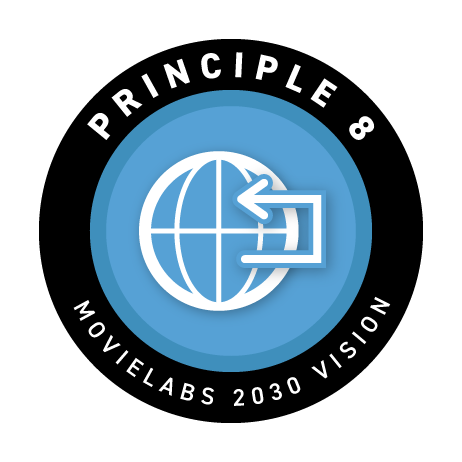
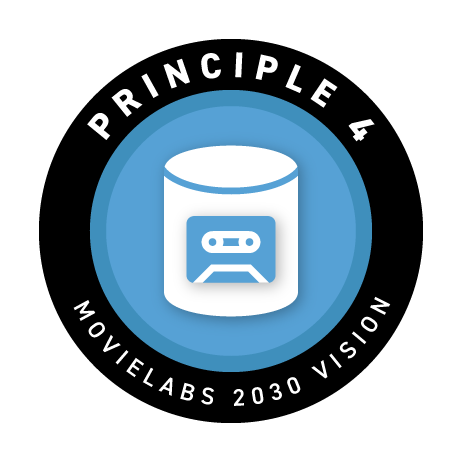
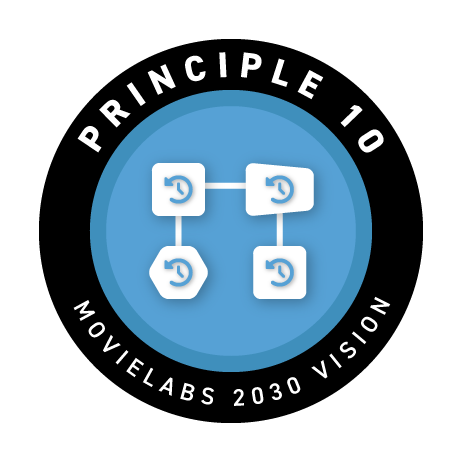
Background
As of this writing, 30+ different titles have been released as part of the Marvel Cinematic Universe since 2008 – one of the most extensive content franchises of all time. All these titles are part of the same universe of characters, themes, locations, and materials. The volume of material created for these films and shows is enormous, with only a small portion ultimately included in the final cut of a released title.
Historically, all the material, whether in the final version or not, was sent to archive for potential future use. Editorial and marketing teams working on new titles, tasked with maintaining overall MCU continuity across a growing number of titles, regularly needed to reference or reuse editorial material from previous works. Getting access to that archived material, however, was not a quick and easy process. Authorized requests came from editorial or marketing to the editorial support teams, who needed to find the right drive in the digital archives, reconnect and put it online, validate the material and fix any potential corruption, mount the drive in Avid Nexis, relink the editorial bins, confirm security arrangements, then make the material available to the requesting team in a Media Composer instance (see Fig 1). After the requesting team reviewed and made selections, the files were copied to local Media Composer bins, and then the whole set of materials was returned to the archive.
The entire process took up to two weeks with involvement by production or marketing teams, editorial support teams, archivists, and Marvel Studios’ internal Avid engineering support. Even with the process streamlined over time, it still required five (5) working days and involved the production team, one or more editors, a post-production supervisor, and 1-2 Avid engineers. After each request, all the works were discarded until the next request arrived. With the repository of historical work constantly growing, everyone involved knew there had to be a better way.
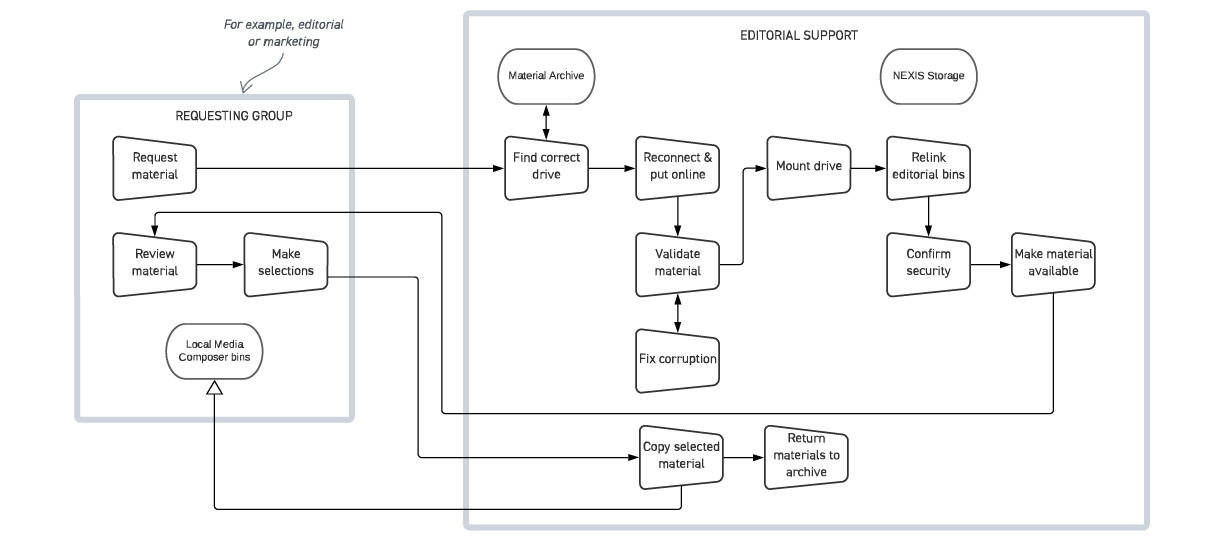
Figure 1: The steps required to pull and validate files from the offline digital archive are a 1-2 week process involving multiple people
Solution
The MCU-EL solution was to turn the existing digital archive into a searchable library with real-time online access for the editorial and marketing teams who repeatedly need to reference the material.
The goals were to:
- Make all MCU historical materials available for use in new films and shows on a secure, real-time basis.
- Provide robust search and discovery of editorial library assets directly to authorized users looking to reuse archived materials.
- Automate the manual tasks required to source, prepare and deliver the archival assets.
- Maintain continuity and quality of Marvel Studios films by making better use of historical materials.
- Enable a non-proprietary capability that could be used by the whole industry to support franchise, episodic, and other kinds of productions that would benefit from access to reusable libraries.
- Deploy the solution with best-in-class security that meets demanding Marvel Studios standards.
To accomplish these goals, the team repurposed or extended existing Avid applications and services, taking advantage of Avid capabilities built for broadcast management of large news and sports libraries. The team worked with Avid to adapt those tools to support the vast volume of clips, subclips, and assets available in the MCU archive, as well as the complex web of relationships between them. The MCU-EL system allows every sequence, source clip, and subclip in the Marvel Studios archive to be accessed through a web browser, ingested into a central repository, searched remotely, and delivered back to storage. When media is found and selected for reuse, an editor simply right clicks “send to show”, and the media is placed in Media Composer project bins for the identified production.
The generic MCU-EL capability (including the customized Avid applications and the metadata indexing and other tools used to build the MCU-EL) can be deployed to support other franchises and is available today inside Disney for deployment on other Disney franchises such as Star Wars, etc.
Architecture
The MCU-EL solution relies largely on pre-existing Avid components and services created for broadcast news and sports. Disney collaborated with Avid engineers to create custom extensions for Avid products, stitching them together in new ways to make them more applicable for long form media archives and more able to support efficient reuse of the millions of clips and subclips found in the MCU archive.
The system makes the Marvel Studios editorial library available to authorized Marvel Studios users globally through a private cloud hosting an internal website that integrates with the Avid components and services. The assets and media are securely available to authorized global users on the cross functional teams that support Marvel Studios productions. Performance can be tuned as needed to support global access, e.g., through network optimization of MTU (maximum transmission unit) size and firewall rules and routing.
MCU archive materials are stored centrally in an archival AVID NEXIS shared storage system. Users browse and find materials using the standard Avid Media Central UI (exposed via a cloud UX interface). Retrieval requests trigger the system to build a remote library with the requested materials. A new capability, called Avid MediaCurrents, is used to manage the transfer of assets and associated metadata from archival storage into the remote library, which then can be managed through Media Central | Asset Management or transferred to Media Composer working bins through MediaCurrents. The solution maintains metadata preserving the relationships between source materials and subclips so that only the smaller subclips (transcoded from DNxHD 115 wrapped as OP-Atom MXF into H.264 wrapped as MXF OP-1A proxies that are about 2% the size of the original files) need to be transferred from storage for editor search and discovery. The system includes automated capabilities for single or multi-asset ingest (including entire bins and project folders containing multiple bins), subclip ingest, audio-only asset ingest, and metadata editing and tagging.
The new code required for the solution was created by Avid engineers so that the generic capability could be made available by Avid to all of its customers in the film and television ecosystem.
To ensure the highly secure MCU materials are strictly controlled, any use of the MCU-EL is limited by role of the user on a per-title basis. Security and permissions are based on a Single Sign On (SSO) log-in with two-factor authentication through a secure VPN to restrict access to both the application and the media to only certain users.
To ensure the enormous archive is searchable, the AVID solution was also customized to tag and organize assets in the MCU-EL based on a standard ontology established by the Disney Genome Content management team (Disney’s metadata system). The structure and tagging using the Genome ontology makes the MCU-EL searchable using straightforward categories (such as character name, superhero name, performer, etc.) and also by interrelationships between those categories and narrative and filming locations, other aspects of cast and crew, fictional and production timelines, plus types of scenes, themes, etc. The Disney team created scripts for video indexing using the Genome ontology and also deployed machine learning tools to automate the process of extracting metadata and tagging the assets.
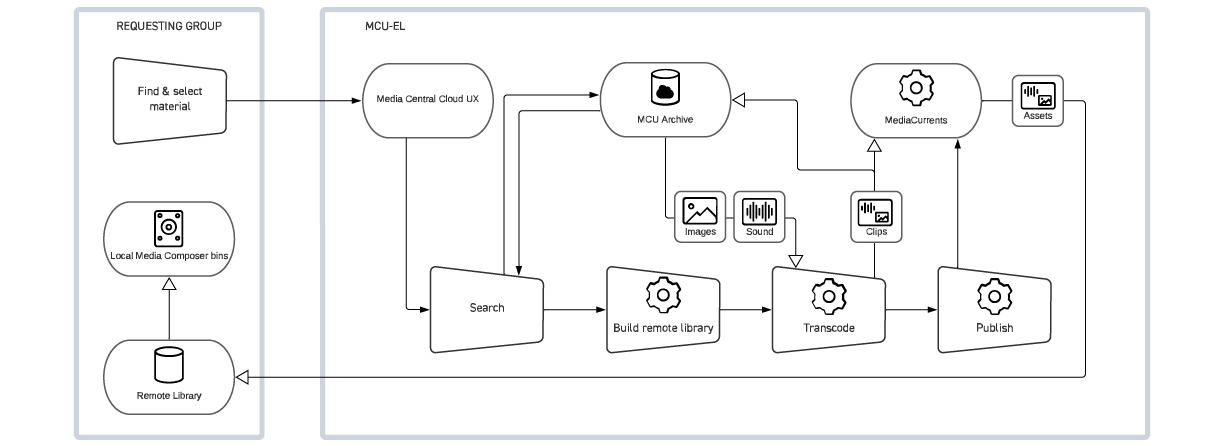
Figure 2: The MCU-EL solution automates many of the processes in retrieving content and provides a simple but powerful web UX
BENEFITS
The ability to quickly locate and repurpose content from the Marvel Studios archive is saving production costs while opening new creative opportunities. Editors have more choices and more time for creative tasks. A key goal is to enable productions to avoid costly reshoots.
The system makes massive volumes of historical material efficiently available to production and marketing teams at Marvel Studios, increasing their ability to maintain quality and continuity across the growing number of MCU titles. Ingesting and tagging a new title takes about one week, and fourteen of 30+ Marvel Studios titles have been made available in the system in under a year of operation, with the goal of ingesting every title. Ingestion of a single movie can start with 4 million files in archive (including frame-based, AAF clips, sound files, documents/paperwork, and massive attic files) and then reduce the total number of ingested assets to under 20,000 after data cleanup and processing.
The ability to have all our material in one easily searchable location will have a transformational impact with both time and cost savings.”
By empowering editors to directly access the MCU-EL, Marvel Studios has sped up new production edits. The system has replaced reliance on group knowledge with a stable searchable solution that provides immediate search results.
Alignment with MovieLabs 2030 Vision Principles
The MCU-EL successfully demonstrates the MovieLabs 2030 Vision principles in multiple ways:
PRINCIPLE 1
The MCU-EL demonstrates the benefits of moving assets from slow physical storage systems (e.g., tape) to rapid access media storage where files can be securely made available to downstream users and processes. This perpetual access to the entire library enables the ongoing curation of the files, rapid access via search and also unlocks new technology such as Artificial Intelligence-based indexing and optimizations of the library which were not easily achieved with offline libraries.

PRINCIPLE 4
The MCU-EL is a perfect example of the intent of Principle 4 – moving from legacy archiving infrastructure to the power of ‘libraries’ of organized, searchable materials from previous Marvel Studios productions, going back more than ten years. The entire system has transformed Marvel Studios’ highly curated and secure offline repository into a cloud utility with access granted on a per-title basis to users in certain roles.

PRINCIPLE 8
The system incorporates a metadata structure built on a comprehensive ontology that cross-references and interrelates assets to make them searchable for users in new and powerful ways. Assets are organized, described, and interrelated using the Disney Content Genome ontology, augmented by automated tagging using machine-learning. The system demonstrates the advantages of a creative and robust search capability with a standardized ontology and metadata structure. In addition, the system couples qualitative content data with technical data about asset formats, dates and times of capture, and relationships and linkages between assets, allowing efficient recovery and repurposing of the assets without extensive offline research.

PRINCIPLE 10
The MCU-EL implements an entirely new self-service,
real-time workflow that completely replaces a time-consuming and resource-intensive process that previously required multiple manual iterations to respond to user feedback. This demonstrates the intent behind Principle 10 – that new technologies can modify processes that took weeks and transform them into real-time interactions enabling creatives to make rapid decisions and iterate in real-time.

Collaborators
Avid was the key collaborator on the MCU-EL project, since much of the work involved updating and extending existing Avid products and services, including AVID NEXIS, AVID Media Central, and AVID Media Currents. A key goal of the project was to enable Avid to deliver an extension of their product suite to enable all studio customers managing large editorial libraries to get the same functionality that Disney is enjoying with the MCU-EL.
NEXT STEPS
The project provided a key lesson around the value of a standardized versus a completely bespoke solution. It might have taken longer to develop a standardized solution, but the final product solves both a specific production need and delivers a more general solution that is supported independently by an established industry vendor and can be leveraged across other Disney franchises and ultimately the entire industry.
The team also learned that moving an on-prem capability to a cloud deployment, even with the same vendor and same software applications, is more complicated than a simple “lift and shift.” Both the on-prem and the cloud deployments can involve more purpose-built features and elements of intentional design than are expected at the start of a cloud move, and not all the features of existing solutions and products can or should be recreated in the new cloud deployment. A cloud deployment requires reprioritization of features and elements, which takes time, but the result, however, has the ability to unlock the power of the cloud with completely new functionalities and efficiencies.
As Disney looks to expand the MCU-EL solution they have identified some key next steps:
- Continue adding more MCU titles to the editorial library to include all released and future Marvel Studios movies, TV shows and animated content.
- Add customized dashboards for editors, engineers, and management, each featuring 3-4 key metrics most relevant for the specific audience.
- Deploy the functionality for other Disney franchises.
- Consider linking the MCU-EL to the Marvel Studios Plates Lab for seamless integration with VFX workflows.
- Extend to other capabilities and assets, such as script resources or vendor applications for workflows like 2D or 3D modeling, re-rendering, and audio processing.
- Make the solution deployable on a hyperscale cloud. That will involve resolving issues around ingress and egress so that the deployment is both feasible and affordable, but it could also help with minimizing global latency and availability.
- Productization of the MCU-EL capability as a generic AVID service, with the goal for it to become a standard product extension of Media Central, broadly available to all.
As media repositories increasingly become cloud-based, Disney and Marvel Studios have a vision and confidence that they can make theatrical films and television shows more efficiently and enable new forms of creative connections and content. Achieving that goal for the entire industry will be a major step forward for implementation of key principles of the MovieLabs 2030 Vision.
MOVIELABS PERSPECTIVE
Disney’s extension of Avid Media Central to expose the entire Marvel Cinematic Universe to its editors demonstrates many parts of the 2030 Vision simultaneously. By moving assets to the cloud Disney can open up access without limiting security and provision files in near real-time that previously took a week or more to be available to editors. The change in process removes tedious and mundane work and frees the creative’s time to iterate and experiment in order to explore archive reuse options for a new show or marketing promotion. This is an example of the benefits of an Automated Workflow – one that is enabled by software with all the inherent benefits of software around speed of development, flexibility to adapt, and ability to add and extend functionality over time. Now that these assets are cloud-enabled in a nimble solution, there is even more opportunity for future innovation from the superheroes in Disney Studio Technology.
Get the Case Study
Download a free PDF of this case study

